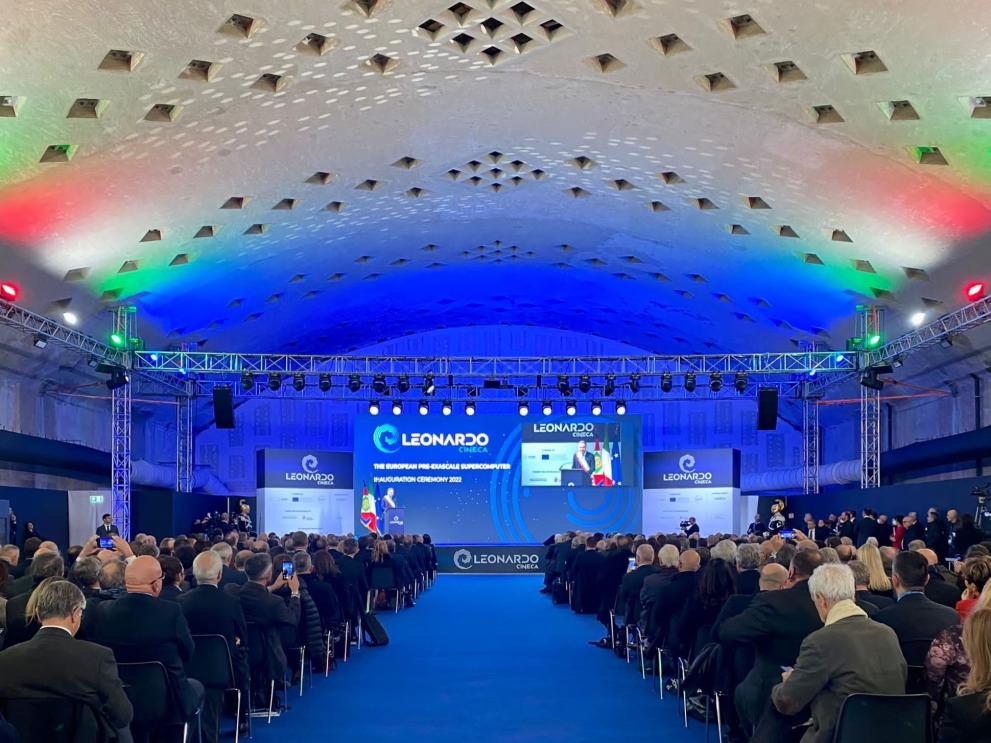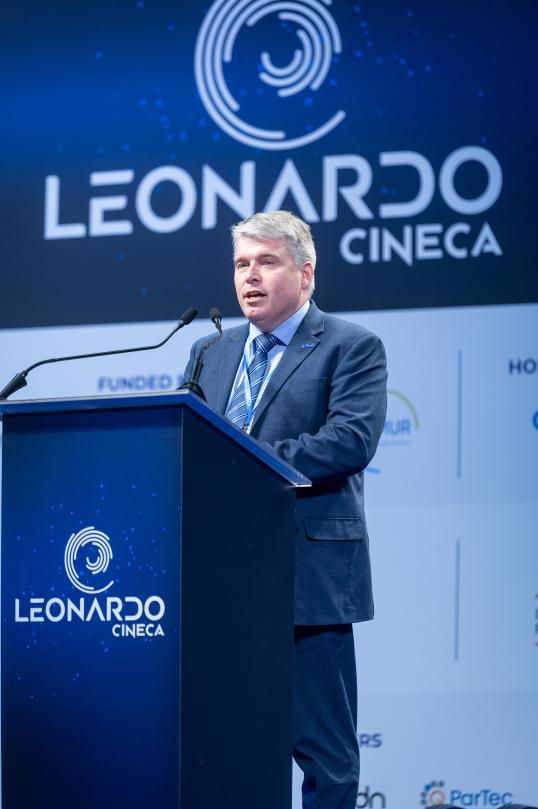
Sergio Mattarella, President of the Italian Republic and Anna Maria Bernini, Italian Minister of University and Research participated in the ceremony. The event was also attended by Roberto Viola, Director General for Communication Networks, Content and Technology, European Commission (CNECT) and Anders Dam Jensen, the EuroHPC JU’s Executive Director.
LEONARDO's system is based on the BullSequana XH2000 solution supplied by Atos and is specifically well suited for high-intensity computing tasks such as data processing, High Performance Data Analytics (HPDA), Artificial Intelligence and machine learning. Leonardo is hosted by CINECA at the Bologna Technopole in Italy.
While the installation of Leonardo only started few months ago, the system is already ranked as the world’s 4th fastest and most powerful supercomputer according to the November 2022 edition of the TOP500 list. This world-leading machine will significantly increase the computing capacity available in Europe and will be a valuable tool for European research and industry supporting innovation and bringing benefits to European citizens in fields such as medicine, energy, climate, and agriculture.
Like all EuroHPC supercomputers, LEONARDO has been designed with a strong consideration for sustainability and eco-conscious supercomputing. The machine employs a water-cooling system for improved energy efficiency and is equipped to adjust its power consumption to ensure a balance between energy saving and performance.
Anders Dam Jensen, Executive Director of the EuroHPC JU, said:
“I am very pleased to celebrate the inauguration of LEONARDO today, particularly after the excellent global ranking it received just a few days ago.
Beyond being an incredibly powerful machine and a further step towards exascale, Leonardo’s architecture also makes it a machine which will be particularly usable by a great number of European users and an important tool for European research and industry.”
Francesco Ubertini, President of Cineca, said:
"It is a great satisfaction for me to officially inaugurate the European supercomputer Leonardo, one of the most powerful supercomputers in the world. The result of a major investment by Europe, with the EuroHPC Joint Undertaking, and the Ministry of University and Research. It is a complex project, starting from the design of the system, configured to support a large, sustainability-oriented production capacity, to the construction of the datacenter that houses it, a custom-built house under Pier Luigi Nervi's vault at the Tecnopolo in Bologna.
Leonardo is not episodic or fortuitous; it is part of Cineca's history, which began more than 50 years ago. If Cineca today is one of the most recognized supercomputing centers in the world, it is thanks to the support of the national system of research institutions, from the guiding action of the national government, and from the ability to develop high-level specialised skills to work alongside scientists and technologists, research institutions and companies. Leonardo, in fact, is not an isolated system but the center of an ecosystem that multiplies opportunities and triggers new trajectories, some already concrete, others that today we only glimpse or imagine and that could soon become reality.
Leonardo is not an end but a means; it has value not for itself but for what it enables. To the scientific community first and foremost, but also to the economic-productive world and the Public Administration: from observing the cosmos to materials science, from space economy to climate change, from genomics to the digital twins of cities and the Earth, from forecasting extreme natural events to personalized medicine, from renewable energy to cybersecurity, from agrifood to cultural heritage, to countering fraud.
It will be up to each and every one of us to ensure that Leonardo generates the expected opportunities, and develops its full potential by raising the frontier of knowledge, to give a strong impulse to the country's and Europe's digital innovation."
More details
Leonardo is owned by the EuroHPC Joint Undertaking and is the result of a joint investment totalling EUR 120 million, from the JU and the Italian Ministry of Universities and Research. The Leonardo Consortium, led by Italy, is made up of six countries: Austria, Greece, Hungary, Italy, Slovenia and Slovakia.
Leonardo is already available through an early-access program. Currently Leonardo is capable of executing more than 174 petaflops or more than 174 million billion calculations per second. It is expected to become fully operational in the first half of 2023 with an expected performance of 250 petaflops. Half of the Leonardo computing resources will be allocated to EuroHPC users, following open periodic and peer-reviewed calls to which all eligible European users may participate.
The hosting entity for Leonardo, CINECA (the Interuniversity Consortium for Automatic Computing in North Eastern Italy) is a non-profit consortium, made up of 70 Italian universities, 40 national institutions and the Italian Ministries of Universities and Research, and of Education.
Background
The EuroHPC JU is a legal and funding entity created in 2018 to enable the European Union and EuroHPC participating countries to coordinate their efforts and pool their resources with the objective of making Europe a world leader in supercomputing. The mission of the EuroHPC JU is:
- to develop, deploy, extend and maintain in the EU a federated, secure hyperconnected supercomputing, quantum computing, service and data infrastructure ecosystem;
- to support the development and uptake of demand-oriented and user-driven innovative and competitive supercomputing and quantum computing systems based on a supply chain that will ensure the availability of components, technologies and knowledge;
- and, to widen the use of that supercomputing and quantum computing infrastructure to a large number of public and private users.
To date the EuroHPC JU has already procured eight supercomputers, located across Europe: LUMI in Finland, LEONARDO in Italy, Vega in Slovenia, MeluXina in Luxembourg, Discoverer in Bulgaria, Karolina in the Czechia, MareNostrum5 in Spain, and Deucalion in Portugal.
In June 2022, the EuroHPC JU announced the selection of new sites across the EU to host and operate the next generation of EuroHPC supercomputers.
In October 2022 the EuroHPC JU also announced six sites to host quantum computers, which will be integrated with existing supercomputers.
Details
- Publication date
- 24 November 2022
- Author
- European High-Performance Computing Joint Undertaking

